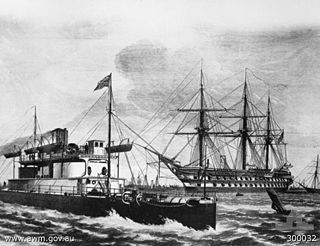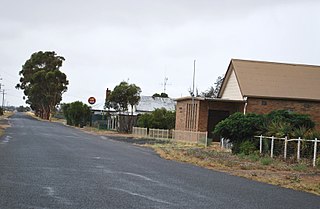
In the 18th century and most of the 19th, a sloop-of-war in the Royal Navy was a warship with a single gun deck that carried up to eighteen guns. The rating system covered all vessels with 20 guns and above; thus, the term sloop-of-war encompassed all the unrated combat vessels, including the very small gun-brigs and cutters. In technical terms, even the more specialised bomb vessels and fireships were classed as sloops-of-war, and in practice these were employed in the sloop role when not carrying out their specialised functions.

HMVS Cerberus is a breastwork monitor that served in the Victoria Naval Forces, the Commonwealth Naval Forces (CNF), and the Royal Australian Navy (RAN) between 1871 and 1924.

A whaleboat or whaler is a type of open boat that is relatively narrow and pointed at both ends. It was originally developed for whaling, and later became popular for work along beaches, since it does not need to be turned around for beaching or refloating. The term "whaleboat" may be used informally of larger whalers, or of a boat used for whale watching.

HMAS Swan, named for the Swan River, was a River-class destroyer escort of the Royal Australian Navy (RAN). Constructed in Melbourne following the loss of HMAS Voyager, Swan entered service in 1970.

HMAS Canberra was an Adelaide class guided missile frigate of the Royal Australian Navy (RAN). Based on the Oliver Hazard Perry class design, Canberra was one of four Adelaide class ships constructed in the United States of America, and one of six to serve in the RAN.

Rear Admiral Norman von Heldreich Farquhar was an officer in the United States Navy during the American Civil War. He is best known for commanding a naval squadron which was wrecked with three German warships at Apia, Samoa in 1889.

HMS Orpheus was a Jason-class Royal Navy corvette that served as the flagship of the Australian squadron. Orpheus sank off the west coast of Auckland, New Zealand on 7 February 1863: 189 crew out of the ship's complement of 259 died in the disaster, making it the worst maritime tragedy to occur in New Zealand waters.

Before Federation in 1901 five of the six separate colonies maintained their own naval forces for defence. The colonial navies were supported by the ships of the Royal Navy's Australian Station which was established in 1859. The separate colonies maintained control over their respective navies until 1 March 1901, when the Commonwealth Naval Forces was created.

HMS Pelorus was an 18-gun Cruizer-class brig-sloop of the British Royal Navy. She was built in Itchenor, England and launched on 25 June 1808. She saw action in the Napoleonic Wars and in the War of 1812. On anti-slavery patrol off West Africa, she captured four slavers and freed some 1350 slaves. She charted parts of Australia and New Zealand and participated in the First Opium War (1839–1842) before becoming a merchantman and wrecking in 1844 while transporting opium to China.

Netherby is a town in western Victoria, in Australia. The town is approximately 406 kilometres (252 mi) north west from Melbourne.

HMAS Yarra (U77), named for the Yarra River, was a Grimsby-class sloop of the Royal Australian Navy (RAN) that served during World War II. Commissioned in 1936, Yarra spent the early part of the war in Australian waters, then was transferred to the East Indies Station in 1940. The sloop operated in the Red Sea, then was involved in the Anglo-Iraqi War and the Anglo-Soviet invasion of Iran. After operating as part of the Tobruk Ferry Service in the Mediterranean during November, Yarra was reassigned to Southeast Asia in response to Japanese attacks. On 4 March 1942, Yarra was attacked and sunk by a force of Japanese cruisers and destroyers while attempting to protect ships withdrawing to Australia.

HMAS Parramatta (U44) was a Grimsby class sloop of the Royal Australian Navy (RAN). Built during the late 1930s, Parramatta operated in the Red Sea and Mediterranean during World War II. The sloop was torpedoed by the German submarine U-559 on 27 November 1941, and sank with 138 of the 162 aboard.

Currie is the largest township on, and is the administrative centre of, King Island, Tasmania, at the western entrance to Bass Strait. At the 2006 census, Currie had a population of 746.
A range of naval vessels were used in New Zealand from its early settlement years to the formation of the New Zealand Naval Forces in 1913. In the mid-19th century, these vessels included frigates, sloops, schooners, and steam-driven paddlewheel boats. In 1846, five years after New Zealand was first proclaimed a colony, it bought its first gunboat. In the 1840s and 1850s, steam boats were used to survey the ports and the coastline. In the 1860s, New Zealand established the Waikato flotilla, its first de facto navy.

HMS Driver was a Driver-class wooden paddle sloop of the Royal Navy. She is credited with the first global circumnavigation by a steamship when she arrived back in England on 14 May 1847.

HMVS Childers was a torpedo boat of the Victorian Naval Forces, Commonwealth Naval Forces and the Royal Australian Navy.
HMS Hazard was an 18-gun Favorite-class sloop of the Royal Navy. She was one of four Favorite-class ship sloops, which were a ship-rigged and lengthened version of the 1796 Cruizer-class brig-sloop. All four ships of the class were ordered on 10 June 1823. She was launched in 1837 from Portsmouth Dockyard.
Netherby was a full-rigged sailing ship of the Black Ball Line that ran aground and sank off the coast of King Island—an island in Bass Strait between Tasmania and the Australian mainland—on 14 July 1866 while sailing from London to Brisbane.
Major-General Hon. Charles Pasley, C.B., R.E., was a British Army officer and Colonial Engineer, Commissioner of Public Works and politician in colonial Victoria.

William Henry Norman (1812–1869) was a sea captain in Australia. As commander of HMVS Victoria, he engaged in the First Taranaki War in New Zealand and the search for explorers Burke and Wills.
















